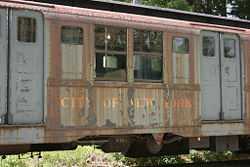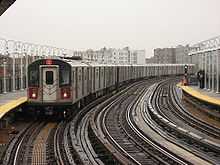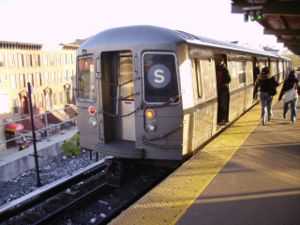R7 (New York City Subway car)
| R7 (New York City Subway car) | |
|---|---|
|
An R7 car at the Seashore Trolley Museum | |
| Manufacturer | American Car and Foundry, Pullman Standard |
| Built at | Chicago, Illinois, USA |
| Constructed | 1937 |
| Entered service | 1938-1939 |
| Scrapped | 1978-1979 |
| Number built | 150 |
| Number preserved | 1 |
| Number scrapped | 149 |
| Fleet numbers | 1400-1549 |
| Capacity | 56 (seated) |
| Operator | New York City Subway |
| Specifications | |
| Car body construction | Riveted steel |
| Car length | 60 ft (18.29 m) |
| Width | 10 ft (3.05 m) |
| Height | 12.08 ft (3.68 m) |
| Platform height | 3.76 ft (1.15 m) |
| Doors | 8 |
| Maximum speed | 55 mph (89 km/h) |
| Weight | 84,653 lb (38,398 kg) |
| Traction system | Westinghouse 570-D5 or General Electric 714-D1, 714-D2 |
| Power output | 190 hp (142 kW). |
| Electric system(s) | 600 V DC Third rail |
| Current collection method | Contact shoe |
| Braking system(s) | WABCO Schedule AMUE with UE-5 universal valve, ME-23 brake stand, and simplex clasp brake rigging. WABCO D-3-F air compressor |
| Coupling system | WABCO H2A |
| Track gauge | 4 ft 8 1⁄2 in (1,435 mm) |
The R7 was a New York City Subway car built in 1937 for the city-operated Independent Subway System by two manufacturers under separate orders, the American Car and Foundry Company and Pullman. It was a continuation of the R6 fleet. The last units operated in service in 1977, and were replaced but the R46 subway car order.
Preservation
Car 1440 survives at the Seashore Trolley Museum in Kennebunkport, Maine, coupled to R4 800 and is used in various tourist rides around the museum.
Further reading
- Sansone, Gene. Evolution of New York City subways: An illustrated history of New York City's transit cars, 1867-1997. New York Transit Museum Press, New York, 1997 ISBN 978-0-9637492-8-4
| |||||||||||||||||||||||||||||||||||||||||||||||||||||||||||



